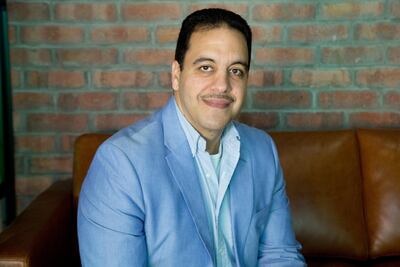Tarek Abdoun, a civil engineer, remembers vividly the time in 1992 when a Cairo building he helped to design began to shake.
"The first thing I thought was that I had done something wrong and the building was collapsing. Everybody started running out. I didn't want to – I wanted to face the consequences," he says.
It soon became clear why the building was moving – an earthquake was happening. And Prof Abdoun, then a young field engineer, realised that seismic activity had not been factored in to the design of the eight-storey structure. The building remained standing while others did not.
That "shake-up" sparked Prof Abdoun's interest and he is now a professor at NYU Abu Dhabi and an award-winning expert on how land, infrastructure and buildings react to earthquakes and other extreme events, including bomb blasts.
Much of his work offers lessons for the Gulf, especially as many buildings in cities such as Dubai are built on reclaimed land. This is more likely to behave in a hazardous way during an earthquake.
“In the Gulf they have a perception, ‘We’re not really in a seismic zone, we shouldn’t worry about it.’ It might not happen frequently, but it’s a risk – it does exist,” he says.
In 2007, a 4.6-magnitude earthquake hit Ras Al Khaimah. The UAE often feels tremors from much stronger earthquakes centred on Iran.
Prof Abdoun’s main area of interest is soil liquefaction — the process by which solid ground turns into a liquid state during an earthquake.
Liquefaction can have terrifying results, causing roads and buildings to collapse and cars and vans to be swallowed up.
"Ninety per cent of the damage that happens to foundations is due to liquefaction," he says.
One of Prof Abdoun's most important pieces of research is why liquefaction could take place in one area but not another, even though both sites have similar sandy soils.
_______________
Read more:
UAE residents feel tremors from 5.5 Iran earthquake off Kish island
New earthquake code for Dubai's tall buildings
'No damage' in Dubai after tremors from Iraq earthquake are felt by residents
_______________
The case study was California where in 2010, a 7.2-magnitude earthquake struck Imperial Valley but failed to cause liquefaction and damage was limited. In contrast, a 6.9-magnitude earthquake 20 years earlier caused liquefaction at the Treasure Island Fire Station site in San Francisco.
Written with three other scientists, the paper found that the Imperial Valley site had endured dozens of earthquakes in the century or so since sandy soils there had been deposited. The San Francisco site had experienced a couple of quakes since the area's sandy soils were left there in the 1930s.
The work offered an important new element to consider – seismic history. This is of much more than academic interest because such insights can be used in building design.
Prof Abdoun, who splits his time between the Centre for Earthquake Engineering Simulation in upstate New York and NYU Abu Dhabi, said: “On the surface [two areas] may look the same, but they’re very, very different based on their character. This has a big impact on the performance.”
When there is uncertainty about the potential risk of damage, designers will often be more conservative and include expensive measures to ensure that a building is highly resistant to earthquakes. These extra costs may be unnecessary.
In 2013, Dubai said buildings of 10 floors or more would be built to withstand earthquakes of up to a magnitude of 5.9 on the Richter scale.
The decision came after the UAE felt tremors from a 7.8-magnitude earthquake near the Iran-Pakistan border.
Experts warned the building code would delay projects for months and raise costs by as much as 10 per cent.
“If you can assess it properly, you might find you don’t need to be extra expensive. You can save a lot of money,” said Prof Abdoun.
He said that in the Gulf region "a lot of questions remain" to be answered about how buildings and infrastructure will endure in the event of a more serious seismic event.
“I see some limited work about high-rise buildings, [but] there’s a lot of real estate that’s not high-rise on reclaimed land – a lot of villa homes on reclaimed land and sandy soils, and not much analysis has been done.”
This could change, not least because Prof Abdoun is setting up a centre at NYU Abu Dhabi which will analyse natural and man-made hazards, from earthquakes to terrorist attacks
.
More than a quarter of a century on from those frightening events in Cairo, Prof Abdoun is still putting buildings and neighbourhoods to the test in the most extreme circumstances.



